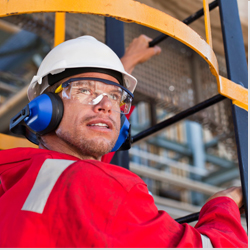Eye protection is a requirement by law under the Personal Protective Equipment At Work Regulation 1992 when working in a hazardous area.
Employers have to provide suitable personal protective equipment to the exposed employee. HSE state that PPE eyewear should be chosen based on the dangers in the specific workplace, with the right combination of protective elements for the tasks at hand.
Typical eye hazards while working
- - Chemical splash - All round unvented eye protection is recommended when working with chemicals to avoid entry into the eyes.
- - Impact hazards - Safety goggles or visors provide suitable protection from impacts to the eyes, but the level of impact hazard should be assessed to inform the specific type of protection needed.
- Loose particles or liquid splash - When there's a risk of flying particles or liquid splash, full face protection may be required. Ventilated full face protection offers the wearer more comfort and breathability while un-ventilated options are safer but less comfortable.
Which safety glasses or goggles to choose?
When you have an understanding of what eye hazards you need to protect against, you can choose the type of protective eyewear that best suits the environment. We offer an extensive range of protective eyewear and
eyewear accessories, including:
- - Safety eye shields - suitable for factory visitors and observers where the risk of flying materials is low.
- - Safety spectacles - for use in environments with a low/medium risk of flying particles.
- - Face shields - suitable where the risk is flying particles and liquid splash and there is a requirement to protect the whole face.
Tinted safety glasses
We have various colours of lens depending on your requirements, including:
- - Clear – Standard protection.
- - Amber – Removes some of the visible blue light, providing better contrast enhancement. Also offers a level of light enhancement when working in low light environments.
- - Grey – Sun glare filter for use outdoors. Also offers UV and impact protection.
- - Brown SCT – A variant on sun glare filter for use outdoors. Also offers UV and impact protection.
European standards for safety glasses
There is a range of European standards that dictate the level of protection that safety glasses and goggles should provide.
- EN 166 - Specification for personal eye protection; applies to all types of eye protection used against various hazards, as encountered in industry, DIY activities etc, which are likely to damage or impair vision, with the exemption of nuclear radiation, x-rays, laser beams and low temperature infrared (IR) radiation emitted low radiation sources.
- EN 170 – Covers the requirements of glasses with ultraviolet filters
- EN 171 – Covers the requirements of glasses with infrared filters
- EN 172 – Covers the requirements of sun glare filters for industrial use
- EN 175 – Covers the requirements of the eye and face protection during welding





Leave a comment